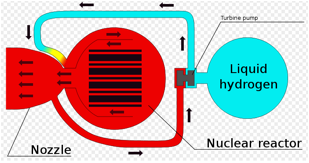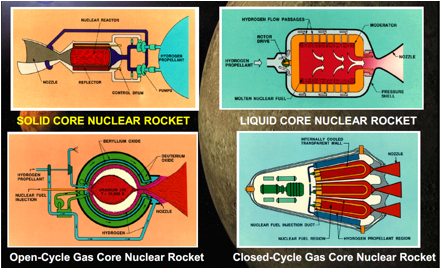Propulsion Systems
Propulsion Technology
There exist only few propulsion systems which may be a good candidate for interstellar propulsion. The most realistic are the following:
Nuclear Thermal Rocket is beyond any doubt the most realistic propulsion system among these candidates. Since 1940, NASA has continuously been carried out by researches about nuclear propulsion. To date, no nuclear thermal rocket has flown but only ground-tested in Lab. Commercial use of nuclear power have enabled a dramatic increase in performance of nuclear reactor so much so that nuclear propulsion is seriously considered for Mars Missions. Indeed, due to the higher energy density of the nuclear fuel compared to chemical fuels, the resulting propellant efficiency (effective exhaust velocity) of the engine is at least twice as good as chemical engines.
The nuclear thermal rocket heats liquid hydrogen, to a high temperature in a nuclear reactor, and then expands through a rocket nozzle to create thrust. The Nuclear Reactor may provide up to 10GW to the propulsion system. The reactor temperatures can reach several tens of thousands of degrees, which allow specific impulses of 3000 to 5000s.

Fig3: Nuclear Thermal Rocket
There are several categories of nuclear thermal rocket which can range from the solid core reactor to the most complicated but more efficient gas core reactor. The three main nuclear reactors are illustrated in Fig.4

The gas core reactor has been chosen for our interstellar travel since it is the most efficient.